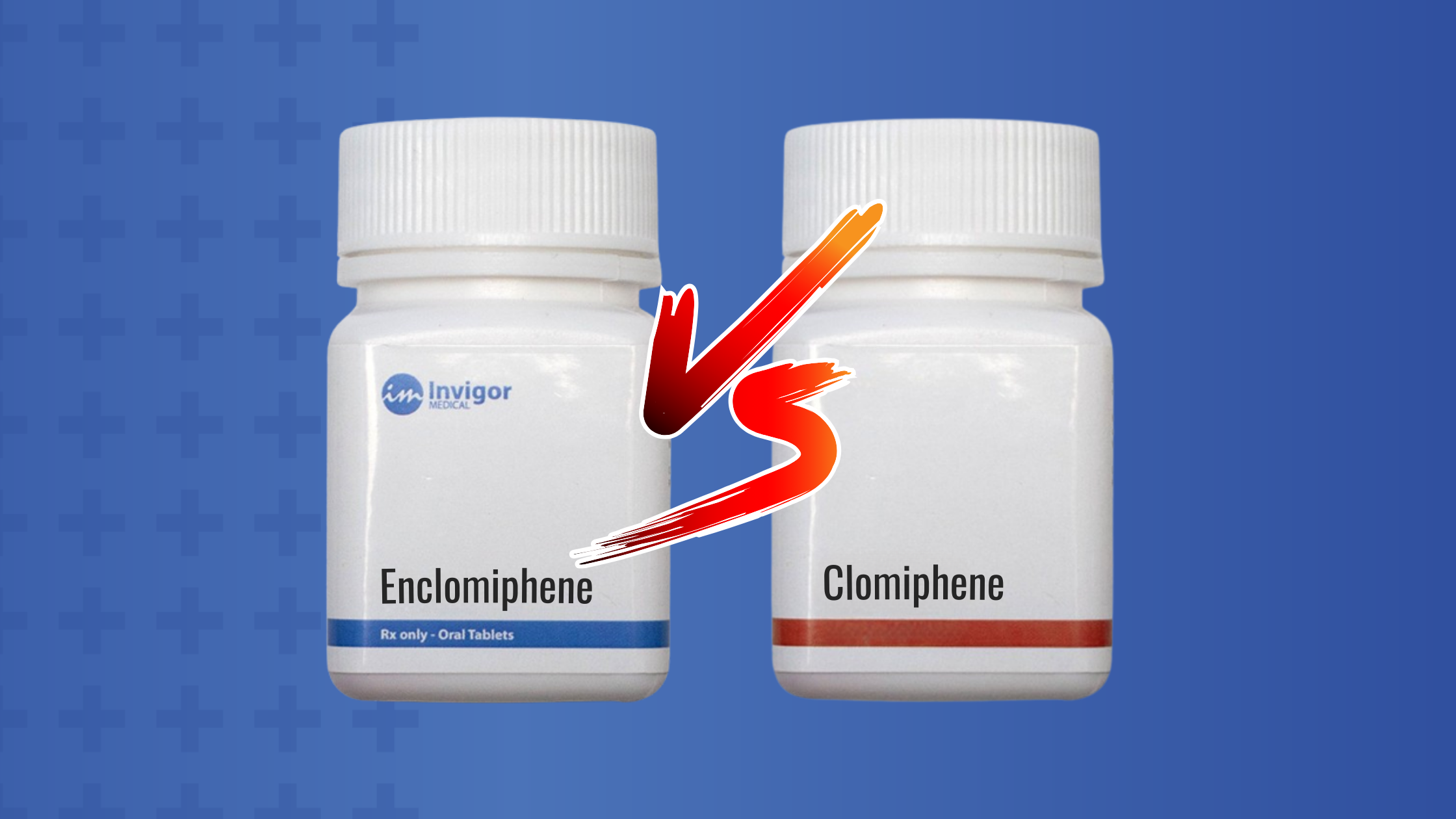When considering treatment options for testosterone replacement therapy, you might find yourself comparing Enclomiphene vs Clomiphene (Clomid). Both medications share benefits such as improving energy levels, enhancing mood, and supporting overall well-being. Whether you’re looking to address symptoms of aging or support healthy testosterone levels, these treatments offer effective solutions.

What Enclomiphene vs Clomiphene (Clomid) Treats
What it Treats
- Improves low testosterone levels in men
- Supports symptoms of hypogonadism
- Enhances energy and mood
- Boosts libido and sexual function
- Helps improve body composition and muscle mass
- Treats infertility in women by stimulating ovulation
- Addresses low testosterone levels in men
- Improves sperm count and motility in men with infertility issues
- Supports symptoms of hypogonadism in men
- Enhances overall reproductive health in both genders
How it Works
Main Benefits
- Treats low testosterone levels in men
- Alleviates symptoms of hypogonadism, such as fatigue and low energy
- Improves sexual function by enhancing libido and erectile function
- Boosts mood and mental clarity by increasing testosterone levels
- Supports muscle mass and body composition by stimulating natural testosterone production
- Stimulates ovulation in women with infertility issues
- Improves sperm count and motility in men with low sperm production
- Treats low testosterone levels in men, improving energy and sexual function
- Regulates menstrual cycles in women with irregular periods due to hormonal imbalances
Administration of Enclomiphene vs Clomiphene (Clomid)
Dosing Requirements
- Enclomiphene is taken orally as a tablet.
- The typical dosage is 12.5 to 25 mg per day, depending on individual needs and doctor recommendations.
- It is generally taken in the morning, with or without food.
- Enclomiphene can be safely combined with vitamins, such as Vitamin D, and testosterone support supplements, under the guidance of a healthcare provider.
- Clomiphene is taken orally as a tablet.
- The typical dosage for men is 25 to 50 mg per day, while women typically take 50 mg to 100 mg per day for ovulation induction.
- It is recommended to take Clomiphene in the evening, with or without food, to minimize side effects.
- Clomiphene can be safely combined with folic acid and other fertility treatments, but always consult a doctor before combining with other medications.
Effect Duration
- Onset Time: Enclomiphene typically begins to show effects within 2-4 weeks of starting treatment.
- Duration of Therapeutic Effects: The therapeutic effects are cumulative, with improvements becoming more noticeable over the first 3-6 months of treatment.
- Immediate or Cumulative: Effects are cumulative, with testosterone levels gradually increasing over time.
- Noticeable Results: Most patients experience noticeable improvements in energy, mood, and libido within 4-6 weeks of use.
- Onset Time: Clomiphene usually shows effects within 2-3 weeks when used for fertility or testosterone therapy.
- Duration of Therapeutic Effects: The duration of effects can vary, but for fertility, ovulation typically occurs within 5-10 days of starting treatment, with ongoing benefits after several cycles.
- Immediate or Cumulative: While some effects, like ovulation, are immediate, others, such as improvements in testosterone levels, accumulate over time.
- Noticeable Results: Women typically notice ovulation within a few weeks, while men see improvements in testosterone and sexual function within 3-6 weeks.
Safety and Side Effects: Enclomiphene vs Clomiphene (Clomid)
Side Effects and Safety
Common Side Effects:
- Mild headache
- Hot flashes
- Fatigue
Rare Side Effects:
- Severe mood changes
- Vision disturbances
- Blood clot risk (rare)
Safety Summary:
Enclomiphene has a generally safe profile with most side effects being mild and temporary, such as headaches or hot flashes. Rare side effects, such as severe mood changes or vision disturbances, are uncommon.
When to Seek Medical Attention:
Seek medical attention if you experience severe mood changes, visual disturbances, or signs of a blood clot (swelling, pain, or redness in the legs).
Drug Interactions:
Enclomiphene may interact with other hormone therapies or medications affecting the liver, so consult a healthcare provider before combining treatments.
Common Side Effects:
- Hot flashes
- Nausea
- Headache
Rare Side Effects:
- Ovarian cysts (in women)
- Visual disturbances
- Mood swings
Safety Summary:
Clomiphene is typically safe for most patients, with side effects like hot flashes and nausea being mild and temporary. However, in some cases, ovarian cysts or visual disturbances may occur and require medical attention.
When to Seek Medical Attention:
If you experience severe mood swings, vision changes, or symptoms of ovarian cysts (pelvic pain), seek immediate medical attention.
Drug Interactions:
Clomiphene may interact with other fertility treatments and medications that affect hormone levels, so consult your doctor before combining treatments.
Ideal Candidates for Enclomiphene vs Clomiphene (Clomid)
Ideal Candidate
Enclomiphene is primarily beneficial for men seeking treatment for low testosterone levels without resorting to external testosterone supplementation.
- Men aged 18-50 with low testosterone or hypogonadism
- Individuals experiencing symptoms like fatigue, low libido, and mood swings
- Those looking to boost testosterone naturally, without injections or topical treatments
Clomiphene is ideal for women seeking to stimulate ovulation or men experiencing fertility issues related to low testosterone.
- Women aged 20-40 with infertility issues related to anovulation or irregular cycles
- Men with low sperm count or motility, typically between 20-40 years old
- Individuals with mild testosterone deficiency who prefer oral treatment for fertility enhancement
Which Medication is Right for You: Enclomiphene or Clomiphene?
Enclomiphene vs Clomiphene (Clomid) presents clear differences in treatment benefits. Enclomiphene’s ability to stimulate natural testosterone production is a key advantage for men seeking a non-invasive solution, while Clomiphene’s primary role in fertility treatment makes it a vital option for women and men with reproductive concerns. Additionally, Enclomiphene’s more gradual improvement in testosterone levels offers long-term benefits, positioning it as the optimal choice for addressing symptoms like fatigue and low libido. Given its effectiveness in supporting testosterone levels, Enclomiphene emerges as the preferred choice for most patients, though Clomiphene remains an important option for fertility-focused care.

